Best Soil For Snake Plants. Snake plants, commonly known as sansevieria or viper’s bowstring hemp or mother-in-law’s tongue, is becoming very popular nowadays. It is a houseplant in the asparagus family. There are many varieties of snake plant with numerous patterns on their leaves.
These patterns attract so many homeowners that they would be a good choice for decoration and landscape design purposes. You either plant new Snake plant or re-potting them are always with the purpose of decoration.
It is a house plant that has thick leaves that are 1 to 4 feet tall and up to 3 inches across. You need a Snake plant soil to grow them.
What are the benefits of planting sansevieria trifasciata
1. Filter the air
The most important benefit of household Snake plant or other succulent plants, it helps to filter indoor air. The Snake plant is one of the few plants that can convert carbon dioxide (CO2) into oxygen during the dark night. Because of this unique feature, makes Snake plant an ideal plant for bedroom decor. During the night, it provides regulation of healthy airflow. Its quality is very effective at producing oxygen.
2. Remove pollutants
Other than that Snake plant remove toxins from the air. According to NASA research, the plant is very good at removing toxins including formaldehyde, trichloroethylene, xylene, toluene, and benzene from the air. These pollutants can be found in an enclosed building. It breaths at night and keep the bedroom have fresh air all night long.
3. Very good looking plant
Other than being one of the best air-purifying houseplants, don’t you think Snake plant looks so nice and unique? The thick and tall foliage looks artificial. The shades of green, yellow or gray with the horizontal stripes make it the most wanted indoor plant or house plant.
4. Anti Allergy
Because the Snake plant releases oxygen, removes CO2 and absorbs harmful pollutants, this will make sure reducing the odds of airborne allergies. There no need for air filters and purifiers. Just surround your bedroom with Snake plants.
5. Easiest and lowest maintenance house plant
Snake plant is one of the best low maintenance succulents or houseplants in the world. It can be placed in full shade, in half shade, in full sun, in half sun, and in lack of water. Basically, it can live anywhere you like them to be. An easy snake plant care.
What is the best Snake plant soil?
The best Snake plant soil that you must choose for planting or repotting a Snake plant is free-draining soil or fast-draining soil. Because Snake plants are prone to root rot when it is overwatered, you do not let your Snake plant sit on moist or soaked soil for a long time. This would be a good garden planning.
It is highly recommended using a soil-less potting mix or the ready to use the mix for cactus and succulent plant. These soil well known to do very well when it comes to good and fast drainage. But if you only have a regular potting mix or regular soil, add some perlite or sand.
A potting mixture without soil is the best choice for sufficient drainage. Use a terracotta pot that will remove water from the saucer and will not trap water inside.
Top 10 best soil for Snake plant comparison chart
| Model | Size | Price | Rating |
|---|---|---|---|
| 1. Premium American White Pumice for Cactus Succulent Soil | 3 quarts | $$ | 4.8 |
| 2. Miracle-Gro Cactus Palm and Citrus Potting Mix | 8 quarts | $$ | 4.7 |
| 3. Succulent & Cactus Soil Mix – Premium Pre-Mixed Fast Draining Blend | 2.5 quarts | $$ | 4.6 |
| 4. Espoma CA4 4-Quart Organic Cactus Mix | 4 quarts | $$ | 4.6 |
| 5. Wonder Soil Premium Cactus Soil & Succulent Soil Mix | 6 LBS (Expands to 24 Quarts) | $$ | 4.5 |
| 6. Sun Gro Horticulture 1410602.Q08P Black Gold Cactus Mix | 8 quarts | $$ | 4.5 |
| 7. Cactus and Succulent Soil Mix – Imperial Blend | 8 quarts | $$ | 4.4 |
| 8. Organic Succulent and Cactus Soil Mix, Potting Soil with Seaweed, Perlite, and Sand/Fast Draining | 4 quarts | $$ | 4.4 |
| 9. Josh’s Frogs Succulent Soil Snake Plant Soil | 1 quarts | $$ | 4.4 |
| 10. Hoffman Organic Cactus and Succulent Soil Mix | 4 quarts | $$ | 4.0 |
6 best soil for Snake plant reviews
1. Hoffman Organic Cactus and Succulent Soil Mix Snake Plant Soil
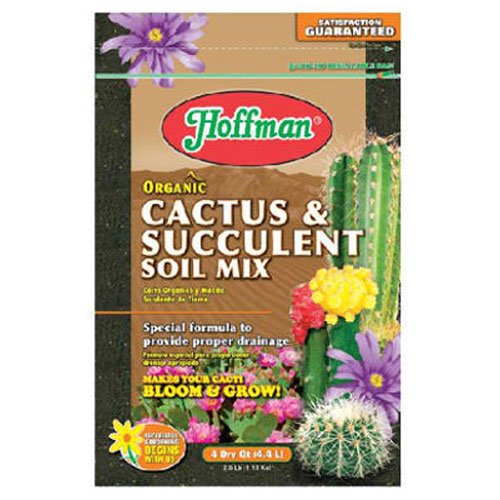
The manufacturer of this soil product is Hoffman. They have specifically designed this formulated soil mix for Snake plants, succulents, desert and jungle cacti, and Aloe Vera. This great formula of soil mix contains a mixture of Canadian sphagnum peat moss, sand, limestone, reed sedge peat, and perlite. This mixture is a great soil mix for most succulents. Because it has been pH balanced, you can use it right out of the bag.
This Snake plant soil mixture also provides very good drainage for your plants. You can read complete directions on the pack and useful growing information for succulent plants.
To make sure that the soil provides the right amount of moisture, follow the instruction manual carefully. If by any chance you find that this soil product is not draining well, just add some gravel to the bottom and push the soil until it reaches the top.
| Model | Size |
|---|---|
| Weight | 10 quarts |
| Use For | Cactus and succulent |
| Feature | Ready to use |
| Ph | Ph Balanced |
| Formula | A mixture of Canadian sphagnum peat moss, sand, limestone, reed sedge peat, and perlite |
2. rePotme Cactus and Succulent Soil Mix – Imperial Blend
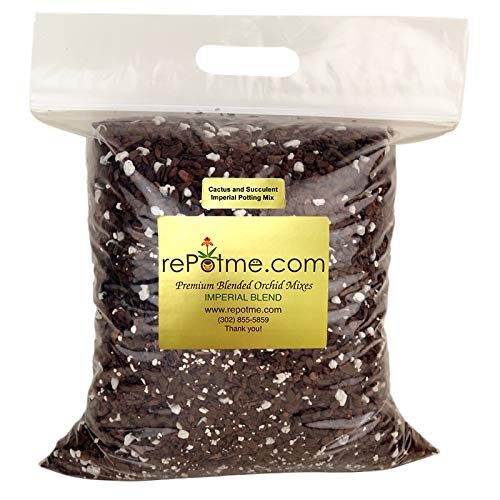
This potting mix is suitable for Snake plant because it contains precision extra small Orchiata Monterey Pine Bark, Small Pumice Rock, Fine Diatomite, and Small Stalite. The Snake plant soil is produced by rePotme as a potting soil mix for cactus and succulent. The Snake plant soil is a free-draining mix.
This mix is a high quality mix suitable also for Plumeria, Christmas Cactus, and Epiphyllums. It is hand-crafted in small batches daily to make sure freshness and quality.
It is mixed with Diatomite, which can be valued as an insecticide, because of its abrasive and physical-sorptive properties. The fine powder helps protect against insects. Utilizing premium ingredients is a vital part of getting rid of fungus gnats. Without peat moss in the mix, it will not attract fungus gnat.
| Model | Size |
|---|---|
| Weight | 8 Quarts |
| Use For | Succulents, Cactus, Plumeria, Christmas Cactus, and Epiphylliums |
| Feature | Ready to use |
| Formula | Monterey Pine Bark from New Zealand, Red Volcanic Rock, Diatomite, and Premium Grade Pumice |
3. Miracle-Gro Cactus Palm and Citrus Potting Mix
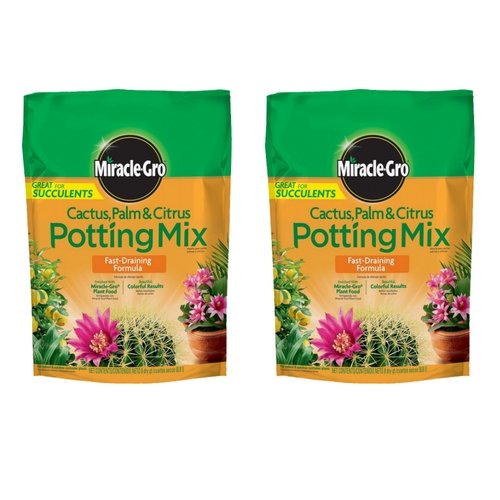
This potting soil mix made by MiracleGro is considered to a strong potting mix for Snake plants, cacti, palms, and citruses. It can be used when potting or re-potting indoor or outdoor plants in containers.
It contains sand, forest products, and perlite. Perlite is a natural filtration system, that allows the water flow for easy draining. It drains away water while retaining a little moisture. At the same time, it catches nutrients that Snake plants need to grow in the growing season.
The good quality fast-draining formula is enriched with plant food for better nutrients and growth. The formula also helps prevent soil compaction and improve drainage. The result would be more beautiful, colorful results.
| Model | Size |
|---|---|
| Weight | 8-Quart |
| Use For | Cactus, Palm, Citruses, Snake plant |
| Feature | Ready to use |
| Formula | NPK |
4. Ramsey Succulent Soil – Organic Cactus Soil Mix, Potting Soil with Seaweed, Perlite, and Sand/Fast Draining Pre-Mixed Course Blend
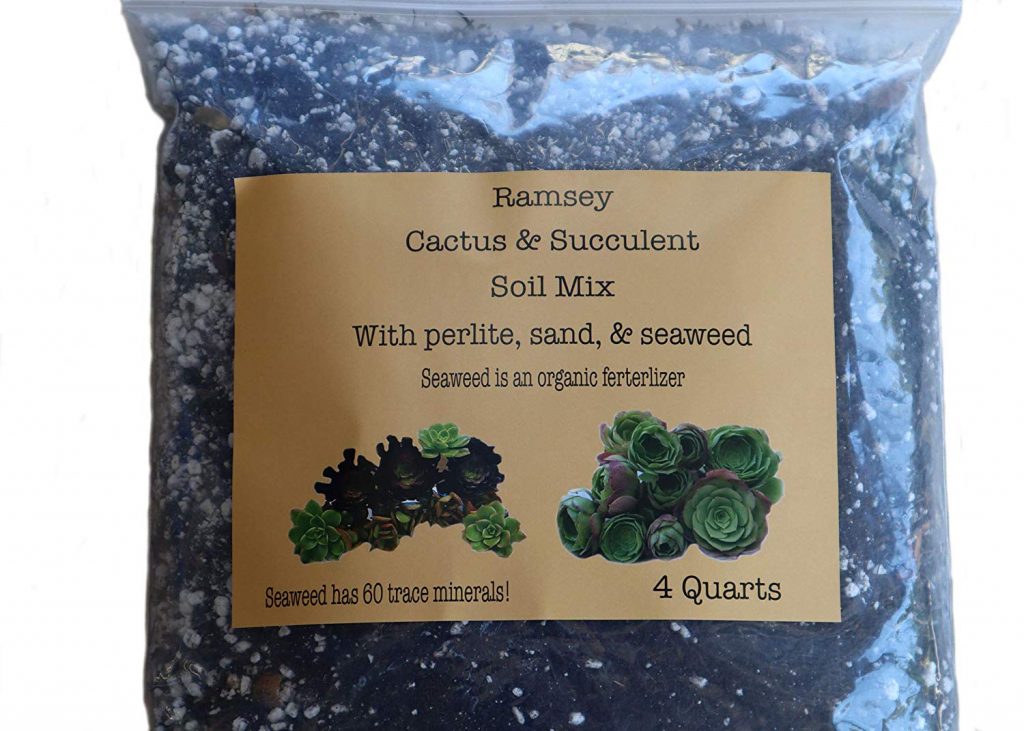
This soil is suitable for the Snake plant to be placed in a pot or container. It is made of sand, seaweed, and perlite. Seaweed is known as a broad spectrum fertilizer that had been trace to contain rich in beneficial trace minerals and hormones. This material can invigorate plant growth.
Seaweed contains carbohydrates at a high rate with proportions of about 45–75 percent carbohydrates and fiber, 7–35 percent proteins, less than 5 percent fats, and a large number of different minerals and vitamins. These materials have a very important role in growing plants.
Seaweed overall has 60 trace minerals and including nitrogen, potassium, phosphate, and magnesium. The sand drains water better than any other type of soil. Perlite gives drainage and stimulates plant growth. This unique soil mixture is a perfect choice for the Snake plant as well as for all cactus and succulents. Your Snake plants will grow healthy and beautiful.
| Model | Size |
|---|---|
| Weight | 4-Quart |
| Use For | Snake plant |
| Feature | Gives drainage and stimulates plant growth |
| Formula | Sand, seaweed, and perlite |
5. Premium American White Pumice for Cactus Succulent Soil
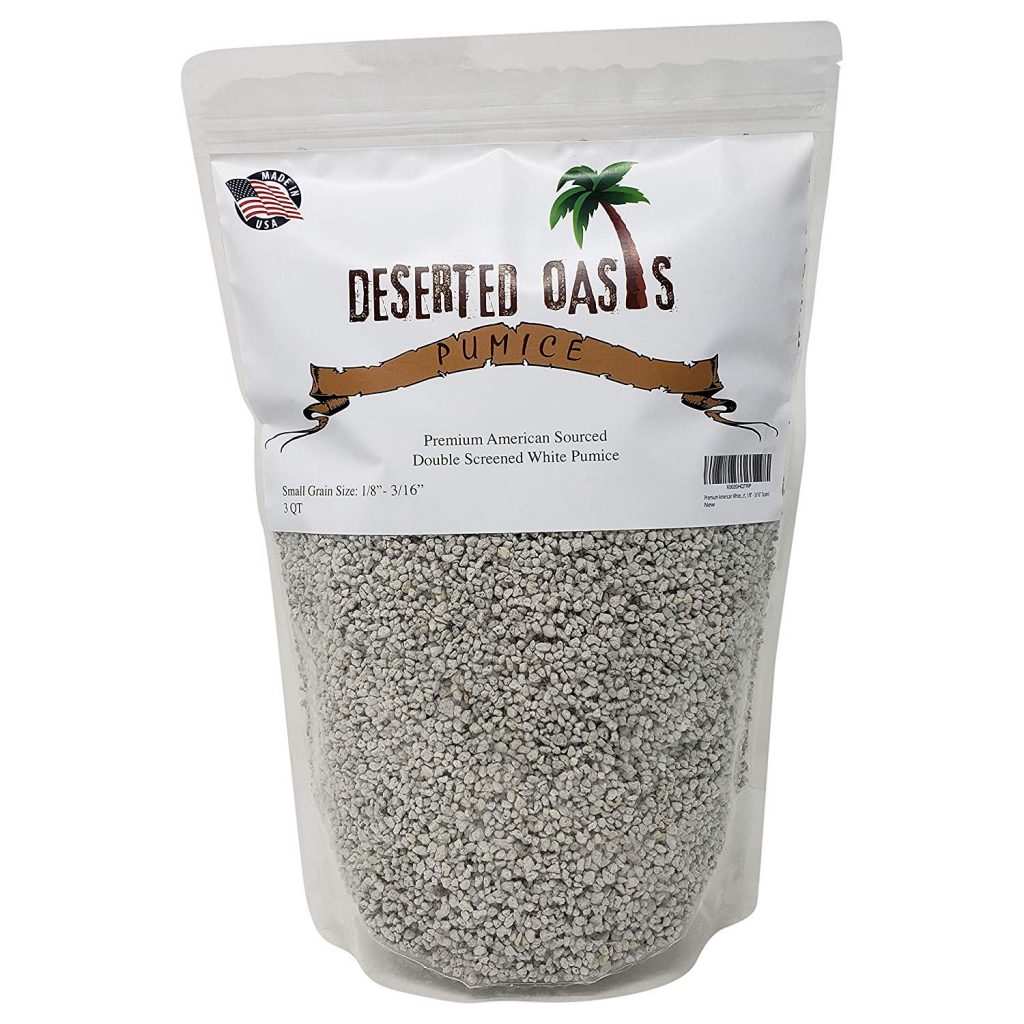
This product is suitable for Snake plant, most types of cactus and succulents. If you already have soil, it can also be used as an additive to custom soil mixes.
It is a mined product from volcanic eruptions. The source has small amounts of volcanic cinder or black lava or granite.
The black lava is ideal to provide control of moisture and improve water drainage. It will also help prevent soil compaction and will not break down over time.
| Model | Size |
|---|---|
| Weight | 3-Quart |
| Use For | Snake plant, Cactus, Succulent |
| Feature | An additive to custom soil mixes |
| Formula | Volcanic cinder or black lava or granite |
6. Josh’s Frogs Succulent Soil
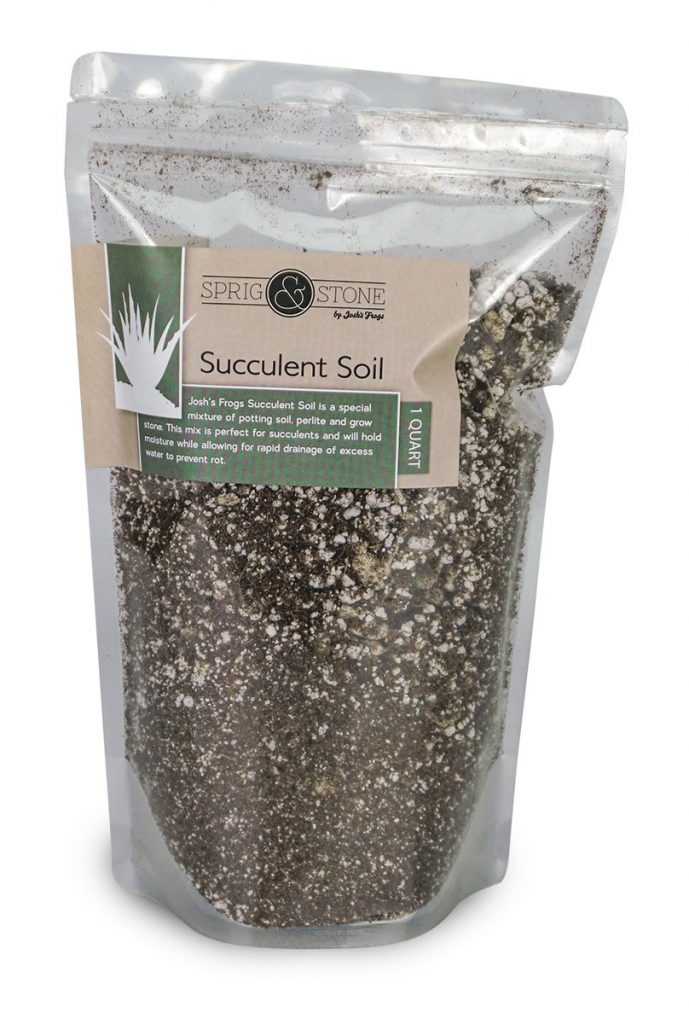
This soil product is a special mixture of small gravel, perlite, and potting soil. The gravel will provide fast draining of water and will let air get to the roots.
It would be the key to Snake plant health. This soil blend is suitable for succulent including the Snake plant. The mix is the key to good Snake plant and succulent plant health.
| Model | Size |
|---|---|
| Weight | 1-Quart |
| Use For | Snake plant, Succulent |
| Feature | Good for plant health |
| Formula | Small gravel, perlite, and potting soil |
How to Plant a Snake plant in a pot?
Step 1
The first step is to choose a plastic pot or container that comes with drainage holes to drain excess water. The pot should be no more than one third larger than the root ball of the Snake plant. Because the roots of snake plants grow aggressively, the plastic pot will not crack.
Step 2
The second step would be to fill the container one-third of the way full with a fast-draining potting mix. This will prevent and help low-water plants grow big and strong.
Step 3
The third step is to place the Snake plant in the pot or container, ensure that the top of the root ball is about an inch below the rim. This space is to allow leave room for watering. Fill in added soil around the root ball and press gently to make it compact.
Step 4
The last step is to water your snake plant and let it drain. You can place it on a catch tray or saucer and move it to its new area that you like.
How to choose a location for the Snake plant?
Snake plants like the location where it is bright, indirect light and also direct sunlight. If you find a shady corner or low light areas, they also can grow but more slowly.
The plant prefers to be in a warm spot with temperatures above 50° Fahrenheit or about 10° Celsius. During winter months, protect the Snake plant from drafty windows.
Best care for snake plants (care tips or care guide)
Watering
If you are watering the Snake plant, you have to make sure to keep the soil dry. If any chance possible, you must water from the Snake plant from the bottom of the pot.
Why from the bottom? The intention is to encourage the roots to grow downward, help to stabilize the tall and thick leaves.
During winter months, it is recommended to water one time in one month. Remove dust from the leaves with a damp cloth.
Propagate snake plants
Snake plants may be needed to be divided every year because of their rapid growth.
Do the dividing in spring months and re-pot them. Cut out containing both roots and leaves (leaf-cutting). Re-pot them with a well-draining potting mix.
If you take care of them well, it will flower occasionally. The greenish-white flower appears on tall spikes.
How to handle problems with Snake plants?
Snake plants are naturally easy to grow. Not many problems that you will encounter with Snake plants. If you notice a change of leaves color turn all green, it is time to locate them to an area with more light or indirect sunlight.
The most common problems are root rot. It is caused by overwatering. If it happens, remove any dying leaves and allow the plant to dry out.
Snake plants have resiliency and can recover well. If you see the plant is dying, remove it from its pot. Eliminate rotted roots and leaves, and re-pot in fresh soil.
When to re-pot Snake plants?
The best time to repot Snake plants every 3 to 6 years. Do not repot them every year or in 2 years because they grow slowly pot bound.
Repotting depends on the size of the pot and the size of the Snake plant. Do not re-pot during winter because it is the time when Snake plants are resting.
Use the best soil for Snake plants to be successful when re-potting.


